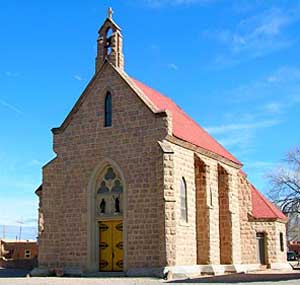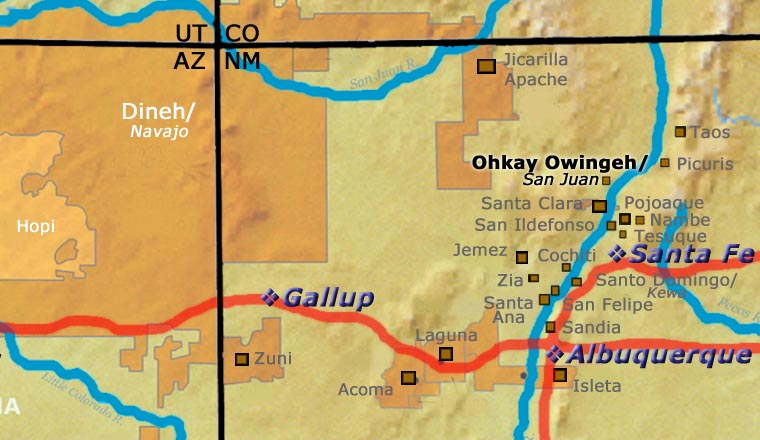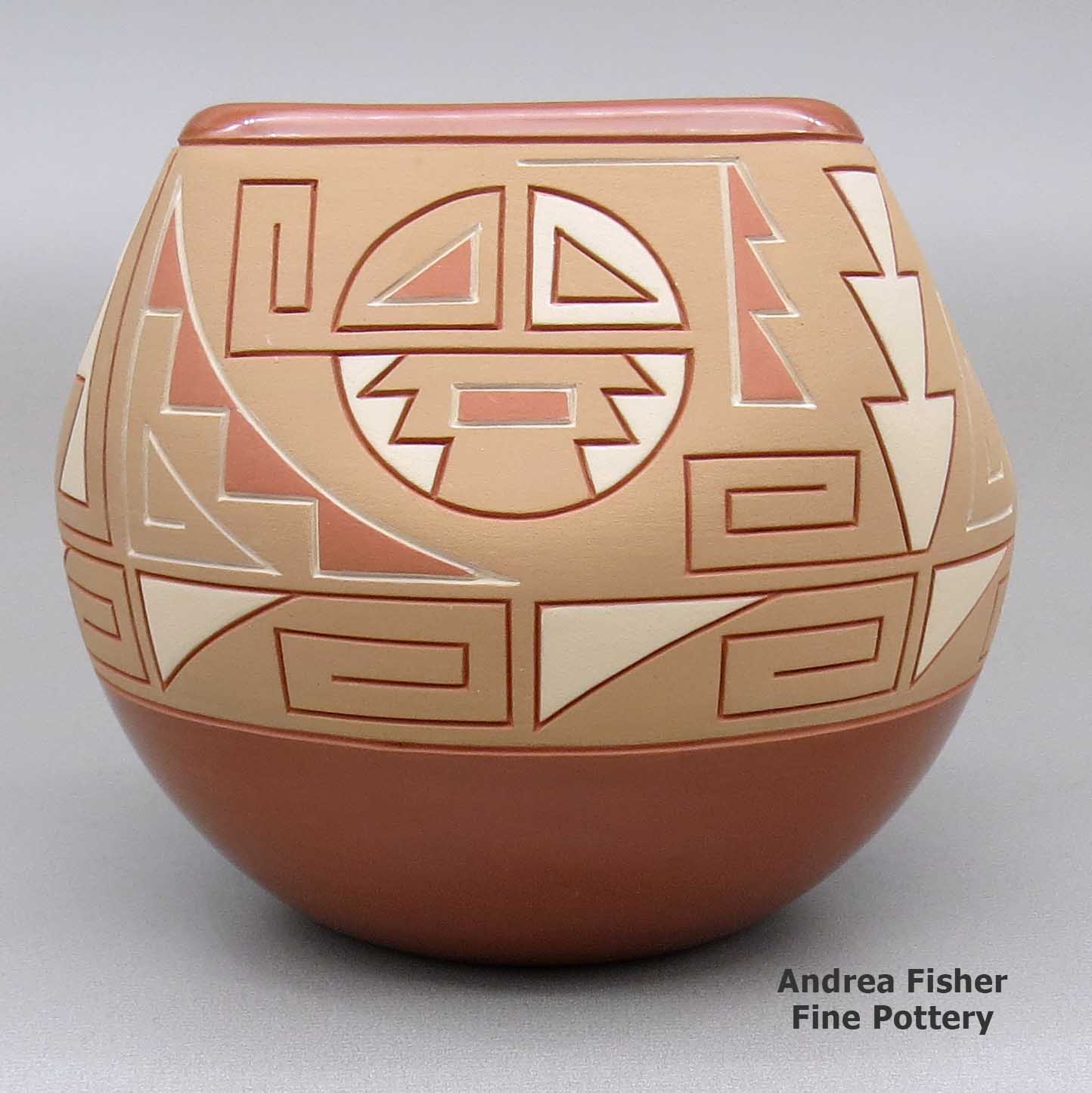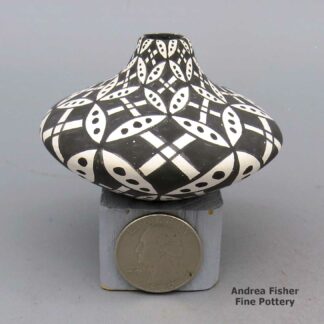| Dimensions | 5 × 5 × 4.25 in |
|---|---|
| Condition of Piece | Very good, has light scratches |
| Signature | Alvin Curran San Juan Pueblo, with hallmark |
Alvin Curran, zzsj2m512, Polychrome bowl with feather and geometric design
$2,200.00
A polychrome jar with a square opening and decorated with a sgraffito-and-painted feather and geometric design
In stock
Brand
Curran, Alvin
He grew up at Ohkay Owingeh, graduated from Espanola High School and studied law enforcement at Monterey Peninsula College. Then he returned to Ohkay Owingeh and worked on the police force, eventually serving as Chief of Police for four years.
Alvin met his wife, Dolores, at a jewelry class. They married in 1978 and she moved to his home at Ohkay Owingeh. They had 2 children together.
Alvin's health began to suffer and when he decided it was time to leave the Police Department, his mother-in-law, Ursulita Naranjo, encouraged him to become a potter. She gave him clay and told him to make something. He made a few animal figures that she polished and fired for him. She told him he had a great opening looking him in the face: there were only a few San Juan potters and none of them were men. Most were elderly women. Then he began to learn in earnest.
After years of work, Alvin developed his own version of the Potsuwi'i jar. Most Potsuwi'i design leaves a lot of open space between major elements but Alvin liked to fill in open areas with detailed decorations. Then he fired his pieces the traditional way, outdoors on the ground.
Alvin was a participant in the Santa Fe Indian Market in 1992, 1993, 1994, 1996 and 1997, earning awards every time.
Alvin said he liked to be working on 3 pots at the same time. He also liked to fire three pots at the same time. Alvin passed on in 2000.
Some of the Awards Alvin earned
- 1997 Santa Fe Indian Market. Classification II - pottery, Division C - traditional pottery, Category 1008 - plates: First Place
- 1996 Santa Fe Indian Market. Classification II - pottery, Division C - traditional pottery, Category 1008 - plates: Second Place
- 1994 Santa Fe Indian Market. Classification II - pottery, Division C - traditional pottery, Category 1001 - San Juan Style: First Place
- 1993 Santa Fe Indian Market. Classification II - pottery, Division C - traditional pottery, Best of Division; - Category 1001: First Place & Second Place
- 1992 Santa Fe Indian Market. Classification II - pottery, Division C - traditional pottery. Category 1001 - all forms: First Place & Second Place
A Short History of Ohkay Owingeh

In 2005 San Juan Pueblo officially changed its name back to its original name (before the Spanish arrived): Ohkay Owingeh (meaning: Place of the strong people). The pueblo was founded after 1200 CE during the time of the great Southwest drought and migrations. The people speak Tewa and may have come to the Rio Grande area from southwestern Colorado or from the San Luis Valley in central Colorado.
Spanish conquistador Don Juan de Oñate took control of the pueblo in 1598, renaming it San Juan de los Caballeros (after his patron saint, John the Baptist). He established the first Spanish capitol of Nuevo Mexico across the Rio Grande in an area he named San Gabriel. In 1608, the capitol was moved south to an uninhabited area that became the Santa Fe we know today.
After 80 years of progressively deteriorating living conditions under Spanish rule, the people of Ohkay Owingeh participated in the Pueblo Revolt of 1680 (one of the revolt's ringleaders, Popé, was a spiritual leader at Ohkay Owingeh) and helped to expel the Spanish from Nuevo Mexico for 12 years. However, when the Spanish returned in 1692 that tribal unity had fallen apart and the individual pueblos were relatively easy for the Spanish to reconquer.
Today, Ohkay Owingeh is the largest Tewa-speaking pueblo (in population and land) but few of the younger generations are interested in carrying on with many of the tribe's traditional arts and crafts (such as the making of pottery). The pueblo is home to the Eight Northern Indian Pueblos Council, the Oke-Oweenge Arts Cooperative, the San Juan Lakes Recreation Area and the Ohkay Casino & Resort. The tribe's Tsay Corporation is one of northern New Mexico's largest private employers.

For more info:
Ohkay Owingeh at Wikipedia
Pueblos of the Rio Grande, Daniel Gibson, ISBN-13:978-1-887896-26-9, Rio Nuevo Publishers, 2001
About Jars
The jar is a basic utilitarian shape, a container generally for cooking food, storing grain or for carrying and storing water. The jar's outer surface is a canvas where potters have been expressing their religious visions and stories for centuries.
In Sinagua pueblos (in northern Arizona), the people made very large jars and buried them up to their openings in the floors of the hidden-most rooms in their pueblo. They kept those jars filled with water but also kept smaller jars of meat and other perishables inside those jars in the water. It's a form of refrigeration still in use among indigenous people around the world.
Where bowls tend to be low, wide and with large openings, jars tend to be more globular: taller, less wide and with smaller openings.
For a potter looking at decorating her piece, bowls are often decorated inside and out while most jars are decorated only on the outside. Jars have a natural continuity to their design surface where bowls have a natural break at the rim, effectively yielding two design surfaces on which separate or complimentary stories can be told.
Before the mid-1800s, storage jars tended to be quite large. Cooking jars and water jars varied in size depending on how many people they were designed to serve. Then came American traders with enameled metal cookware, ceramic dishes and metal eating utensils...Some pueblos embraced those traders immediately while others took several generations to let them and their innovations in. Either way, opening those doors led to the virtual collapse of utilitarian pottery-making in most pueblos by the early 1900s.
In the 1920s there was a marked shift away from the machinations of individual traders and more toward marketing Native American pottery as an artform. Maria Martinez was becoming known through her exhibitions at various major industrial fairs around the country and Nampeyo of Hano was demonstrating her art for the Fred Harvey Company at the Grand Canyon. The first few years of the Santa Fe Indian Market helped to solidify that movement and propel it forward. It took another couple generations of artists to open other venues for their art across the country and turn Native American art into the phenomenon it has become.
Today's jars are artwork, not at all for utilitarian purposes, and their shapes, sizes and decorations have evolved to reflect that shift.
About Geometric Designs
"Geometric design" is a catch-all term. Yes, we use it to denote some kind of geometric design but that can include everything from symbols, icons and designs from ancient rock art to lace and calico patterns imported by early European pioneers to geometric patterns from digital computer art. In some pueblos, the symbols and patterns denoting mountains, forest, wildlife, birds and other elements sometimes look more like computer art that has little-to-no resemblance to what we have been told they symbolize. Some are built-up layers of patterns, too, each with its own meaning.
"Checkerboard" is a geometric design but a simple black-and-white checkerboard can be interpreted as clouds or stars in the sky, a stormy night, falling rain or snow, corn in the field, kernels of corn on the cob and a host of other things. It all depends on the context it is used in, and it can have several meanings in that context at the same time. Depending on how the colored squares are filled in, various basket weave patterns can easily be made, too.
"Cuadrillos" is a term from Mata Ortiz. It denotes a checkerboard-like design using tiny squares filled in with paints to construct larger patterns.
"Kiva step" is a stepped geometric design pattern denoting a path into the spiritual dimension of the kiva. "Spiral mesa" is a similar pattern, although easily interpreted with other meanings, too. The Dineh have a similar "cloud terrace" pattern.
That said, "geometric designs" proliferated on Puebloan pottery after the Spanish, Mexican and American settlers arrived with their European-made (or influenced) fabrics and ceramics. The newcomers' dinner dishes and printed fabrics contributed much material to the pueblo potters design palette, so much and for so long that many of those imported designs and patterns are considered "traditional" now.






